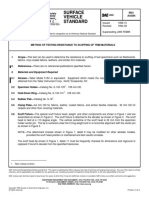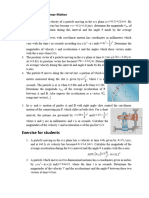SAEJ391 V 001
SAEJ391 V 001
Uploaded by
anupthattaCopyright:
Available Formats
SAEJ391 V 001
SAEJ391 V 001
Uploaded by
anupthattaOriginal Title
Copyright
Available Formats
Share this document
Did you find this document useful?
Is this content inappropriate?
Copyright:
Available Formats
SAEJ391 V 001
SAEJ391 V 001
Uploaded by
anupthattaCopyright:
Available Formats
SURFACE J391
REAF.
JUL81
VEHICLE
400 Commonwealth Drive, Warrendale, PA 15096-0001
RECOMMENDED Issued 1969-05
PRACTICE Reaffirmed 1981-07
Superseding J391 MAY69
Submitted for recognition as an American National Standard
DEFINITION FOR PARTICLE SIZE
Foreword—This Document has not changed other than to put it into the new SAE Technical Standards Board
Format.
1. Scope—"Effective particle or domain size" is a phrase used in X-ray diffraction literature to describe the size of
the coherent regions within a material which are diffracting. Coherency in this sense means diffracting as a
unit. Small particle size causes X-ray line broadening and as such can be measured. It has been shown
related to substructure as observed in transmission electron microscopy. Particle size is affected by
hardening, cold working, and fatigue; conversely, there is increasing evidence that particle size, per se, affects
both static and dynamic strength.
2. References—There are no referenced publications specified herein
3. Definition
3.1 Effective Particle or Domain Size—as determined by diffraction, is a one-dimensional measure of the
average size of essentially perfect regions within a material.
NOTE—Such regions are related to the substructure seen in transmission electron microscopy. Small particle
size contributes to diffraction line broadening.
PREPARED BY THE SAE FATIGUE DESIGN AND EVALUATION COMMITTEE
SAE Technical Standards Board Rules provide that: “This report is published by SAE to advance the state of technical and engineering sciences. The use of this report is entirely
voluntary, and its applicability and suitability for any particular use, including any patent infringement arising therefrom, is the sole responsibility of the user.”
SAE reviews each technical report at least every five years at which time it may be reaffirmed, revised, or cancelled. SAE invites your written comments and suggestions.
QUESTIONS REGARDING THIS DOCUMENT: (412) 772-8512 FAX: (412) 776-0243
TO PLACE A DOCUMENT ORDER; (412) 776-4970 FAX: (412) 776-0790
SAE WEB ADDRESS http://www.sae.org
Copyright 1981 Society of Automotive Engineers, Inc.
All rights reserved. Printed in U.S.A.
SAE J391 Reaffirmed JUL81
Rationale—Not applicable.
Relationship of SAE Standard to ISO Standard—Not applicable.
Application—"Effective particle or domain size" is a phrase used in X-ray diffraction literature to describe the
size of the coherent regions within a material which are diffracting. Coherency in this sense means
diffracting as a unit. Small particle size causes X-ray line broadening and as such can be measured. It
has been shown related to substructure as observed in transmission electron microscopy. Particle size
is affected by hardening, cold working, and fatigue; conversely, there is increasing evidence that particle
size, per se, affects both static and dynamic strength.
Reference Section—There are no referenced publications specified herein.
Developed by the SAE Fatigue Design and Evaluation Committee
You might also like
- Surface Vehicle Standard: Rev. JUN90Document5 pagesSurface Vehicle Standard: Rev. JUN90anupthatta100% (4)
- Sae J2412-2004Document20 pagesSae J2412-2004Brunogeninho100% (1)
- 11505-HF MT (130-220 Ton) Operators Manual X40882e (Sep-03)Document220 pages11505-HF MT (130-220 Ton) Operators Manual X40882e (Sep-03)Ion Plesa50% (2)
- SAE J1390-2017 Engine Cooling Fan Structural AnalysisDocument18 pagesSAE J1390-2017 Engine Cooling Fan Structural AnalysisProvocateur SamaraNo ratings yet
- SAEJ198v001 PDFDocument12 pagesSAEJ198v001 PDFandrefs7No ratings yet
- Lumped Element Rat Race CouplerDocument6 pagesLumped Element Rat Race Couplerbongoloid100% (1)
- Surface Vehicle Recommended PracticeDocument5 pagesSurface Vehicle Recommended Practicewilian_coelho3309No ratings yet
- Sae J518 1993 PDFDocument14 pagesSae J518 1993 PDFdinesh panchal67% (3)
- Surface Vehicle InformationDocument13 pagesSurface Vehicle InformationanupthattaNo ratings yet
- Surface Vehicle Information: Rev. MAR96Document30 pagesSurface Vehicle Information: Rev. MAR96anupthattaNo ratings yet
- Surface Vehicle Recommended PracticeDocument5 pagesSurface Vehicle Recommended PracticeanupthattaNo ratings yet
- Atom Practice TestDocument5 pagesAtom Practice TestJohn Van Dave TaturoNo ratings yet
- Surface Vehicle Recommended Practice: Reaf. JUL81Document2 pagesSurface Vehicle Recommended Practice: Reaf. JUL81wilian_coelho3309No ratings yet
- Sae J1960-2008Document2 pagesSae J1960-2008NameNo ratings yet
- Saej1885 2008Document21 pagesSaej1885 2008Ying QuNo ratings yet
- Surface Vehicle Information: Rev. FEB91Document7 pagesSurface Vehicle Information: Rev. FEB91Glauco SantosNo ratings yet
- SAEJ731 V 001Document5 pagesSAEJ731 V 001Marcelo ColomboNo ratings yet
- Saej 378 V 002Document17 pagesSaej 378 V 002willianNo ratings yet
- Sae J422 Microscopic Determination of Inclusions in SteelsDocument7 pagesSae J422 Microscopic Determination of Inclusions in SteelsmmocasciNo ratings yet
- SAE J1127 (2009 Handbook)Document20 pagesSAE J1127 (2009 Handbook)vegawisconsinNo ratings yet
- Sae J1131Document5 pagesSae J1131Felipe SoaresNo ratings yet
- SAE J427v001Document8 pagesSAE J427v001alferedNo ratings yet
- Sae - Plastic Materials For Use in Optical Parts Such As Lenses and Reflex Reflectors of Motor Vehicle Lighting DevicesDocument5 pagesSae - Plastic Materials For Use in Optical Parts Such As Lenses and Reflex Reflectors of Motor Vehicle Lighting DevicesbillytortolaNo ratings yet
- Surface Vehicle Recommended PracticeDocument3 pagesSurface Vehicle Recommended Practicewilian_coelho3309No ratings yet
- Sae J1960-2008Document15 pagesSae J1960-2008sharma.sumeet2290No ratings yet
- J419 (Dezembro 1983)Document8 pagesJ419 (Dezembro 1983)DiegoNo ratings yet
- Saej697v001 SAFETY CHAIN OF FULL TRAILERS OR CONVERTER DOLLIESDocument4 pagesSaej697v001 SAFETY CHAIN OF FULL TRAILERS OR CONVERTER DOLLIESDaniel FarfanNo ratings yet
- SAEJ697 V 001Document4 pagesSAEJ697 V 001Marcelo ColomboNo ratings yet
- SAEJ586 V 001Document10 pagesSAEJ586 V 001Marcelo ColomboNo ratings yet
- SAE 121-1999 去氫脆Document5 pagesSAE 121-1999 去氫脆Paul HsuNo ratings yet
- Sae Arp1331Document12 pagesSae Arp1331niky186No ratings yet
- Surface Vehicle Recommended PracticeDocument5 pagesSurface Vehicle Recommended PracticeCarolina Gaitan50% (2)
- Sae - Rated Suspension Spring CapacityDocument3 pagesSae - Rated Suspension Spring CapacitybillytortolaNo ratings yet
- SAE J1128 (2009 Handbook)Document25 pagesSAE J1128 (2009 Handbook)vegawisconsinNo ratings yet
- SAE-J200 - Classification System For Rubber Materials-2005Document65 pagesSAE-J200 - Classification System For Rubber Materials-2005Tom BrownNo ratings yet
- Saej 135 V 001Document5 pagesSaej 135 V 001BonnerNo ratings yet
- Ourdev 515235Document37 pagesOurdev 515235Wilson PalacioNo ratings yet
- Sae - Rated Operating Load For LoadersDocument3 pagesSae - Rated Operating Load For LoadersbillytortolaNo ratings yet
- Sae J 400 PDFDocument11 pagesSae J 400 PDFTiago Souza50% (2)
- Sae J167-2011Document3 pagesSae J167-2011nelliNo ratings yet
- Sae J1756Document16 pagesSae J1756jose luisNo ratings yet
- SAE-J423: Distribution Statement ADocument9 pagesSAE-J423: Distribution Statement Ayorf1989100% (1)
- Surface Vehicle StandardDocument5 pagesSurface Vehicle StandardanupthattaNo ratings yet
- Sae - Seat Belt Hardware Webbing Abrasion Test ProcedureDocument4 pagesSae - Seat Belt Hardware Webbing Abrasion Test ProcedurebillytortolaNo ratings yet
- SAEJ662 V 002Document3 pagesSAEJ662 V 002Marcelo ColomboNo ratings yet
- SAEJ704 V 001Document4 pagesSAEJ704 V 001Marcelo ColomboNo ratings yet
- Surface Vehicle StandardDocument11 pagesSurface Vehicle StandardanupthattaNo ratings yet
- Surface Vehicle Recommended Practice: Issued OCT1999Document19 pagesSurface Vehicle Recommended Practice: Issued OCT1999Paco LMNo ratings yet
- Sae - School Bus Warning LampsDocument8 pagesSae - School Bus Warning LampsbillytortolaNo ratings yet
- Surface Vehicle Information: Rev. MAR91Document5 pagesSurface Vehicle Information: Rev. MAR91Sinan ChenNo ratings yet
- Saej3000v003 Thermoplastic Elastomer Classification SystemDocument16 pagesSaej3000v003 Thermoplastic Elastomer Classification SystemDaniel Farfan100% (1)
- J1939-13 Off-Board Diagnostic ConnectorDocument7 pagesJ1939-13 Off-Board Diagnostic Connectornuri osman yilmazNo ratings yet
- SAEJ595 V 001Document7 pagesSAEJ595 V 001Marcelo Colombo100% (1)
- Sae - Reflex ReflectorsDocument9 pagesSae - Reflex ReflectorsbillytortolaNo ratings yet
- Wilson & Daleo Inc. Ancaster, Ontario Canada: Gtd111 Alloy Material Study Joseph A. DaleoDocument20 pagesWilson & Daleo Inc. Ancaster, Ontario Canada: Gtd111 Alloy Material Study Joseph A. DaleoLuc GoorenNo ratings yet
- Saej 2800 V 001Document5 pagesSaej 2800 V 001kyletgerberNo ratings yet
- Sae - Passenger Car Identification TerminologyDocument4 pagesSae - Passenger Car Identification TerminologybillytortolaNo ratings yet
- Sae Arp823e-2007Document4 pagesSae Arp823e-2007aleeimeran100% (1)
- Surface Vehicle StandardDocument5 pagesSurface Vehicle StandardanupthattaNo ratings yet
- Sae - Pneumatic Spring TerminologyDocument6 pagesSae - Pneumatic Spring TerminologybillytortolaNo ratings yet
- SAEJ728 V 001Document5 pagesSAEJ728 V 001Marcelo ColomboNo ratings yet
- Saej 1065 V 002Document12 pagesSaej 1065 V 002shivendra79No ratings yet
- Surface Vehicle Recommended Practice: Rev. MAR2005 J1981Document16 pagesSurface Vehicle Recommended Practice: Rev. MAR2005 J1981Ranjit RajendranNo ratings yet
- SAEJ562 V 001Document4 pagesSAEJ562 V 001Marcelo ColomboNo ratings yet
- Wind Turbines in Cold Climates: Icing Impacts and Mitigation SystemsFrom EverandWind Turbines in Cold Climates: Icing Impacts and Mitigation SystemsNo ratings yet
- Narrow Band-Pass Filters for Low Frequency Applications: Evaluation of Eight Electronics Filter Design TopologiesFrom EverandNarrow Band-Pass Filters for Low Frequency Applications: Evaluation of Eight Electronics Filter Design TopologiesNo ratings yet
- Compendium of Atomic Alkali Resistant Optical Thin Films, Diffusion and Electrical Mobility in Diode Pumped Alkali Lasers (DPALs)From EverandCompendium of Atomic Alkali Resistant Optical Thin Films, Diffusion and Electrical Mobility in Diode Pumped Alkali Lasers (DPALs)No ratings yet
- M 00000 14896 1914896XXDocument1 pageM 00000 14896 1914896XXanupthattaNo ratings yet
- Surface Vehicle Information: Rev. JUL76Document18 pagesSurface Vehicle Information: Rev. JUL76anupthattaNo ratings yet
- Surface Vehicle Information: Rev. JUL95Document68 pagesSurface Vehicle Information: Rev. JUL95anupthattaNo ratings yet
- Surface Vehicle Recommended PracticeDocument8 pagesSurface Vehicle Recommended PracticeanupthattaNo ratings yet
- TSX-TLX - User and Maintenance ManualDocument90 pagesTSX-TLX - User and Maintenance Manualanupthatta100% (1)
- Surface Vehicle Standard: Rev. SEP81Document42 pagesSurface Vehicle Standard: Rev. SEP81anupthattaNo ratings yet
- Surface Vehicle Information: Rev. AUG81Document76 pagesSurface Vehicle Information: Rev. AUG81anupthattaNo ratings yet
- Surface Vehicle StandardDocument5 pagesSurface Vehicle StandardanupthattaNo ratings yet
- Surface Vehicle Standard: Rev. JUL86Document3 pagesSurface Vehicle Standard: Rev. JUL86anupthatta100% (1)
- Surface Vehicle Recommended Practice: Rev. FEB77Document4 pagesSurface Vehicle Recommended Practice: Rev. FEB77anupthattaNo ratings yet
- Surface Vehicle Standard: 400 Commonwealth Drive, Warrendale, PA 15096-0001Document4 pagesSurface Vehicle Standard: 400 Commonwealth Drive, Warrendale, PA 15096-0001anupthattaNo ratings yet
- Surface Vehicle StandardDocument5 pagesSurface Vehicle StandardanupthattaNo ratings yet
- Surface Vehicle Standard: 400 Commonwealth Drive, Warrendale, PA 15096-0001Document3 pagesSurface Vehicle Standard: 400 Commonwealth Drive, Warrendale, PA 15096-0001anupthattaNo ratings yet
- Surface Vehicle StandardDocument5 pagesSurface Vehicle StandardanupthattaNo ratings yet
- Surface Vehicle Recommended Practice: 400 Commonwealth Drive, Warrendale, PA 15096-0001Document3 pagesSurface Vehicle Recommended Practice: 400 Commonwealth Drive, Warrendale, PA 15096-0001anupthattaNo ratings yet
- Surface Vehicle Recommended PracticeDocument7 pagesSurface Vehicle Recommended PracticeanupthattaNo ratings yet
- Mensuration BasicsDocument9 pagesMensuration BasicsKimberly ArnoldNo ratings yet
- Thesis AtakanDocument101 pagesThesis Atakanearth friendlyhqNo ratings yet
- VTU Syllabus For Computer ScienceDocument14 pagesVTU Syllabus For Computer Scienceroshanpoudel21No ratings yet
- Earthquake Damage and Seismic Code For BuildingsDocument10 pagesEarthquake Damage and Seismic Code For BuildingshemalcmistryNo ratings yet
- Commercial & Institutional Lighting Range: Price List 2020Document100 pagesCommercial & Institutional Lighting Range: Price List 2020ramakrishna550No ratings yet
- Chapter 6 Properties of HaloalkaneDocument5 pagesChapter 6 Properties of HaloalkaneRen Liew Jia QingNo ratings yet
- Compressed Air PlantDocument24 pagesCompressed Air Plantliezaebot100% (5)
- SAE Viscosity Grades: DescriptionDocument5 pagesSAE Viscosity Grades: Descriptionimen mehriNo ratings yet
- Fluid Statics: Fluid Mechanics: Fundamentals and ApplicationsDocument18 pagesFluid Statics: Fluid Mechanics: Fundamentals and ApplicationsRoy HernandezNo ratings yet
- 3rd Issue (2019) PDFDocument251 pages3rd Issue (2019) PDFFebiola StephaniNo ratings yet
- SSC IV - DiagnosticDocument3 pagesSSC IV - DiagnosticAjo Sjeaony TeancealNo ratings yet
- Arc Length Method For Passing Limit PointsDocument17 pagesArc Length Method For Passing Limit PointsozkanhasanNo ratings yet
- Brain Teasers 1 10Document11 pagesBrain Teasers 1 10api-204236998No ratings yet
- Iset 438Document13 pagesIset 438Nona AnnisaNo ratings yet
- Testdrive SeDocument214 pagesTestdrive Sevul1234No ratings yet
- Worksheet 3. Curvilinear MotionDocument3 pagesWorksheet 3. Curvilinear MotionKaleab ZenabuNo ratings yet
- Practical No. 3: To Determine Mechanical Properties From Stress, Strain Curve DataDocument6 pagesPractical No. 3: To Determine Mechanical Properties From Stress, Strain Curve Datasagar kordeNo ratings yet
- Chapter-1 - Plastic Analysis Lecture Notes Part-1Document48 pagesChapter-1 - Plastic Analysis Lecture Notes Part-1noladawitNo ratings yet
- Sampling and Sampling DistributionsDocument78 pagesSampling and Sampling DistributionsASHISH100% (22)
- Manual Zyggot Arco v2 1 P (Obsoleto)Document28 pagesManual Zyggot Arco v2 1 P (Obsoleto)Wendel GonçalvesNo ratings yet
- NF A35 080 1 Compress PDFDocument21 pagesNF A35 080 1 Compress PDFbeshoy naseefNo ratings yet
- Dimensional Analysis AND Similarity: Chapter-5. (Frank White)Document46 pagesDimensional Analysis AND Similarity: Chapter-5. (Frank White)ShujaAmjadNo ratings yet
- Programme: Civil Engineering: Government College of Engineering, KaradDocument50 pagesProgramme: Civil Engineering: Government College of Engineering, KaradRohit SharmaNo ratings yet
- Yuken Catalog PDFDocument840 pagesYuken Catalog PDFPiotr100% (2)
- Fundamentals of Twin-Screw Extrusion Polymer Melting: Common Pitfalls and How To Avoid ThemDocument6 pagesFundamentals of Twin-Screw Extrusion Polymer Melting: Common Pitfalls and How To Avoid ThemPrasanth VeeraNo ratings yet
- NDT CompleteDocument57 pagesNDT CompleteabdulazizNo ratings yet
- NASTRAN/PATRAN Intro ManualDocument248 pagesNASTRAN/PATRAN Intro Manualjarzola11No ratings yet











































































































